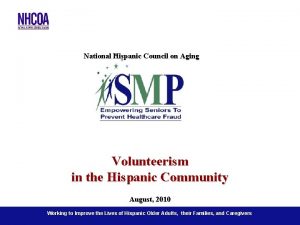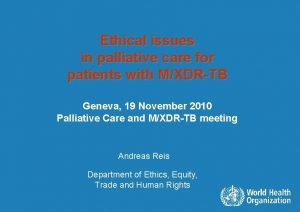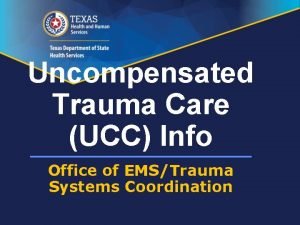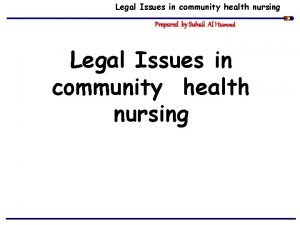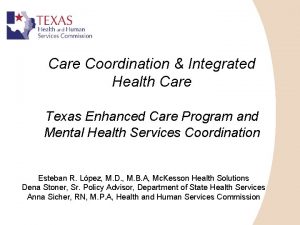Hispanic Health and Health Care Issues in Texas




















- Slides: 20

Hispanic Health and Health Care Issues in Texas and the United States Karl Eschbach, Ph. D. University of Texas Medical Branch

Purpose • To give a context for understanding health care accessibility issues for Hispanics in Texas and the United States

Topics of remarks 1) Population growth 2) Composition of the Hispanic population 3) Health status of Hispanics 4) Health care access 5) Regional burden in Texas 6) The undocumented population

Hispanics as percentage of U. S. population, 1940 -2004

Hispanics in Texas and United States • United States, 2004: – 41. 3 million; – 14. 1 % • Texas, 2003: – 7. 6 million – 34. 2 % Source: U. S. Census Estimates Program

Projected Hispanic Growth to 2040, U. S. & Texas Sources: U. S. Census Bureau; Texas State Data Center

Composition • 86%+ of Texas Hispanics are Mexican origin (U. S. =60%) • 31% of Texas Hispanics are immigrants (U. S. =40%) • Hispanics have lower average education • Concentration in service work, precision production, craft, repair, construction and transportation

Health status: the Hispanic Paradox • Low age-specific mortality rates for the Hispanic population of the United States compared to the non-Hispanic White population despite socioeconomic disadvantage.

Mortality by Hispanic Status (Sorlie et al JAMA 1993) • Standarized mortality rate ratio for Hispanics vs. Non-Hispanic Whites: . 74 men. 82 women • Lower heart disease and cancer mortality • Birth outcomes are similar to non-Hispanic Whites • Hispanic advantage is larger for immigrants

Cause of the mortality advantage • Better health behaviors • Health selective migration

Implications • Hispanics do not impose an excessive health care burden because of poor health habits, extra burden of illness, higher use of medical care

Limited access to health insurance coverage • Concentration in industries and occupations with limited insurance coverage. • Unauthorized migration status limits access to public programs.

Health Insurance, U. S. Hispanics, 2003 Source: National Health Interview Survey, 2003

No health insurance, 2003, National data Source: National Health Interview Survey, 2003

Implications of lower insurance coverage • Lower rates of health care utilization • Lower screening and immunization rates • Less likely to have a regular provider of care • Shorter survival after diagnosis • Informal cross-border health care utilization

Unauthorized immigrant populations • 80%+ of recent Mexican immigrants are unauthorized • 1. 4 million in Texas, 10 million in U. S. • 31 % of undocumented households include citizen children Source: Jeffrey Passel, Pew Hispanic Center

Implications • Texas and the United States depend on immigrant labor • Neither employers or federal/state government take responsibility for paying for medical care • Burden falls on the local hospital districts and other providers and on the immigrants

County of residence of Texas Hispanics Blue=U. S. Born Red=Immigrants

Implications of regional concentration • Local concentrations of un-insured immigrant populations in major metropolitan centers burdens local hospital districts. • South Texas border communities have low coverage rates despite more native presence.

Conclusions • Hispanics are a rapidly growing population • Hispanics are a relatively healthy population • Health insurance rates are far lower • Health care access is impaired • Burden on local health care providers • Trends will magnify these problems if they are not addressed
 Famous hispanic singers and actors
Famous hispanic singers and actors Primary secondary tertiary health care definition
Primary secondary tertiary health care definition Health and social care values unit 2
Health and social care values unit 2 Hispanic cultural views on teenage pregnancy
Hispanic cultural views on teenage pregnancy National hispanic council on aging
National hispanic council on aging Hispanic american scientists
Hispanic american scientists Is hispanic an ethnicity
Is hispanic an ethnicity Servingness
Servingness Domestic violence in the hispanic community
Domestic violence in the hispanic community Most famous hispanic artists
Most famous hispanic artists Hispanic dude
Hispanic dude Health and social component 3
Health and social component 3 Ethical issues in palliative care
Ethical issues in palliative care Uncompensated trauma care application texas
Uncompensated trauma care application texas Ethical and legal issues in community health nursing
Ethical and legal issues in community health nursing Texas health and safety code 343
Texas health and safety code 343 West yorkshire and harrogate health and care partnership
West yorkshire and harrogate health and care partnership Humber coast and vale ics map
Humber coast and vale ics map Appraisal health and social care
Appraisal health and social care Verna and sam barriers
Verna and sam barriers What is a contemporary health issue
What is a contemporary health issue




